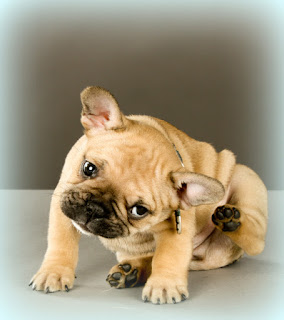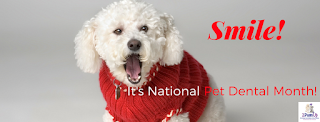Fleas: The First Response
So
you found a flea on your dog. What do you do now? It’s safe to assume that
where you find one flea, there will be many more. The presence of an adult
flea, whether on your dog or in your home, indicates that you will have many
more fleas in other stages of development, from eggs, to larvae, to pupae.
Fast action is your best first response when seeking to divert a full-blown flea infestation. The sooner you remove the adult fleas, the fewer eggs they will be able to produce. However, you must also be prepared to treat and remove the next waves of adult fleas already on their way. Use the following methods repeatedly over a period of weeks to keep the flea populations down.
First, remove the fleas from your dog. If you have spot-on flea treatment, apply it immediately to your pet. Certain flea treatments should be given 4 to 5 days before or after a bath since the dog’s skin oils are needed to make the treatment more effective. If you do not have any flea treatments handy, give your dog a full bath and comb-down.
Many pet owners have used Dawn soap as a quick home remedy for fleas. There are also many commercial shampoos for flea treatment. Be sure to follow all directions on the product labels. A soap bath helps to trap and immobilize fleas because they get caught in the soap. Treated shampoos also act as flea killers. Try working up the soap suds first and then applying them to your dog’s coat. This will limit the time for fleas to escape since rinsing your dog first will give them a chance to leap away. After soaping your dog up, use a comb to remove the fleas, frequently dipping the comb in soapy water to clear off the fleas and prevent you from redistributing them in your dog’s coat.
It may be well worth your effort to buy a comb specially designed for flea removal. These combs are often very fine-toothed. It will take time to comb your dog with such a fine comb, but remember that time spent early will save a multitude of time later if you can avoid fighting a full flea infestation.
A bath and comb down will help to remove adult fleas as well as dislodge flea eggs, larvae, and pupae. Know your own dog’s skin sensitivity and be careful to gauge if the soap treatment is drying out your dog’s skin too much. Consult with your veterinarian about the best product for your dog.
Bathing your dog is only a first response to remove the fleas and relieve your dog from the itching the flea bites will cause. Without further treatment, the fleas can return within a few days. See the article “Fleas: Treatment Ideas” for information about more long-term and preventative treatments.
Second, after a good dog bath, your next line of action against the fleas is to clean any of the areas that your dog likes to frequent. The biggest culprit for a flea breeding ground will be doggy bedding, where eggs may have fallen off your dog and begun to develop. Wash your dog bedding on its own in the washing machine, using strong detergent and the highest temperature possible. Once you have dried the bedding, be sure to clean out and dispose of the lint in the lint trap. Also pay attention to beds, couches, or chairs where your dog likes to sleep.
For anything that you can’t put in the washing machine, clean it thoroughly with a vacuum. It will also be well worth your time to vacuum all your carpets. When you do so, be sure to move your furniture and vacuum the areas that are usually covered since those spots are the dark and cool places where flea larvae like to spend their time.
After vacuuming your home and furniture, be sure to remove and dispose of your vacuum bag or, if you have a bag less model, clean out your vacuum canister and filter. Don’t stop at just cleaning out the vacuum; remove the vacuum waste completely from your home by immediately taking out the trash. This will prevent the fleas from jumping out of your kitchen trash can and right back on to your dog.
An alternative some dog owners use is to put a flea collar in their vacuum bag. Ideally this will kill the fleas that are vacuumed up and save you the trouble of emptying your bag after each cleaning session.
After your first response of cleaning your dog and your home environment, you will want to follow up with treatments and preventative measures that will keep the fleas at bay. See future articles for more tips on treating fleas in your yard and home.
Content Source - http://www.2pawsupinc.com/2014/04/28/fleas-the-first-response/
For more- http://www.2pawsupinc.com
Fast action is your best first response when seeking to divert a full-blown flea infestation. The sooner you remove the adult fleas, the fewer eggs they will be able to produce. However, you must also be prepared to treat and remove the next waves of adult fleas already on their way. Use the following methods repeatedly over a period of weeks to keep the flea populations down.
First, remove the fleas from your dog. If you have spot-on flea treatment, apply it immediately to your pet. Certain flea treatments should be given 4 to 5 days before or after a bath since the dog’s skin oils are needed to make the treatment more effective. If you do not have any flea treatments handy, give your dog a full bath and comb-down.
Many pet owners have used Dawn soap as a quick home remedy for fleas. There are also many commercial shampoos for flea treatment. Be sure to follow all directions on the product labels. A soap bath helps to trap and immobilize fleas because they get caught in the soap. Treated shampoos also act as flea killers. Try working up the soap suds first and then applying them to your dog’s coat. This will limit the time for fleas to escape since rinsing your dog first will give them a chance to leap away. After soaping your dog up, use a comb to remove the fleas, frequently dipping the comb in soapy water to clear off the fleas and prevent you from redistributing them in your dog’s coat.
It may be well worth your effort to buy a comb specially designed for flea removal. These combs are often very fine-toothed. It will take time to comb your dog with such a fine comb, but remember that time spent early will save a multitude of time later if you can avoid fighting a full flea infestation.
A bath and comb down will help to remove adult fleas as well as dislodge flea eggs, larvae, and pupae. Know your own dog’s skin sensitivity and be careful to gauge if the soap treatment is drying out your dog’s skin too much. Consult with your veterinarian about the best product for your dog.
Bathing your dog is only a first response to remove the fleas and relieve your dog from the itching the flea bites will cause. Without further treatment, the fleas can return within a few days. See the article “Fleas: Treatment Ideas” for information about more long-term and preventative treatments.
Second, after a good dog bath, your next line of action against the fleas is to clean any of the areas that your dog likes to frequent. The biggest culprit for a flea breeding ground will be doggy bedding, where eggs may have fallen off your dog and begun to develop. Wash your dog bedding on its own in the washing machine, using strong detergent and the highest temperature possible. Once you have dried the bedding, be sure to clean out and dispose of the lint in the lint trap. Also pay attention to beds, couches, or chairs where your dog likes to sleep.
For anything that you can’t put in the washing machine, clean it thoroughly with a vacuum. It will also be well worth your time to vacuum all your carpets. When you do so, be sure to move your furniture and vacuum the areas that are usually covered since those spots are the dark and cool places where flea larvae like to spend their time.
After vacuuming your home and furniture, be sure to remove and dispose of your vacuum bag or, if you have a bag less model, clean out your vacuum canister and filter. Don’t stop at just cleaning out the vacuum; remove the vacuum waste completely from your home by immediately taking out the trash. This will prevent the fleas from jumping out of your kitchen trash can and right back on to your dog.
An alternative some dog owners use is to put a flea collar in their vacuum bag. Ideally this will kill the fleas that are vacuumed up and save you the trouble of emptying your bag after each cleaning session.
After your first response of cleaning your dog and your home environment, you will want to follow up with treatments and preventative measures that will keep the fleas at bay. See future articles for more tips on treating fleas in your yard and home.
Content Source - http://www.2pawsupinc.com/2014/04/28/fleas-the-first-response/
For more- http://www.2pawsupinc.com




Comments
Post a Comment